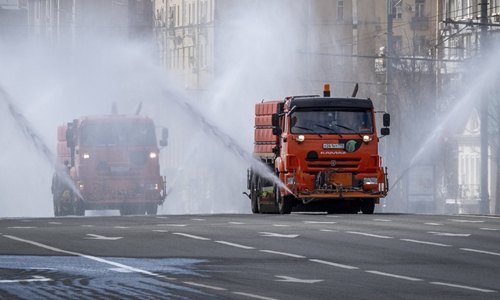Russian alarm on imported infection risk: Global Times editorial
Source:Global Times Published: 2020/4/13 22:58:13

Municipal vehicles spray disinfectant on the deserted streets of central Moscow on Sunday during a strict lockdown in Russia to stop the spread of COVID-19, caused by the novel coronavirus. Photo: AFP
The number of imported cases from Russia has surged. At least 409 imported cases from Russia have been confirmed as of press time, China's largest source of imported cases.The China-Russia border city of Suifenhe has been hit hard by returnees from Russia by land. Since the start of April, every flight from Russia to China has seen a high rate of infection, suggesting the worsening situation in Russia.
Russia is the latest example of a failure to control imported cases and can serve as a warning to others. When the virus wreaked havoc in Europe, Russia appeared to have successfully blocked the epidemic outside its border. It was only on March 2 that the country reported its first case, much later than Western Europe and the US. Russia has also imposed strict restrictions on the entry of Chinese travelers. But it eventually failed to curb the epidemic.
Russian experts said hundreds of thousands of Russian citizens returned from Italy, France, Spain and other Western European countries in late March. Most of them ended up in Moscow or transited through the capital, making the city the worst-hit area within Russia. Europe is one of the global hubs. It would be much tougher for Russia to guard against cases from there than from China.
The virus knows no borders or races. The Chinese people have watched Russia became a severely affected country from one that did a great job. This should sound the alarm: China must strictly prevent the inflow of cases and avoid a second outbreak.
For China, understanding this is perhaps more important than coping with the large number of imported cases from Russia. The anti-pandemic fight is a protracted one, and we cannot lose any battle.
Northeast China's Heilongjiang Province and others are facing a major test from the sudden influx of infected people from Russia. But it is believed that they are able to handle it. And the central government is also mobilizing and ready to provide support.
Another problem is how to avoid panic of Chinese people returning home. That will increase the risk of those compatriots and also increase the difficulty of China's response.
Some say there are 1.5 million Chinese people in Russia. But according to Da Zhigang, a Chinese expert based in Heilongjiang, the number should be around 100,000. Some of them are worried that Russia's prevention and control system is weak and the medical system may break down. They know that China has done a good job in domestic prevention and medical care is guaranteed. Thus, the willingness to return to China is strong among them.
For Chinese people in Russia, we encourage them to stay where they are to avoid being infected. The most effective way to prevent infection is to implement strict self-quarantine. The risk of long-distance travel is very high. The flight from Moscow to Shanghai on Friday carried 204 people and 60 people have been diagnosed with COVID-19 so far. This was the flight with the most confirmed cases since the global outbreak. We cannot confirm how many of them were infected during their trip, but the ratio is not low.
Among those who returned to China from Russia through the Suifenhe land port, the infection rate was also very high. This has sounded the alarm for the Chinese people in Russia. The actual infection rate in Russia is likely to be high, and every flight to China imposes a great risk to healthy passengers. If it were not the last resort, Chinese people in Russia should not take the risk.
China and Russia are comprehensive strategic partners of coordination for a new era. They should have enough political will and resources to coordinate supporting Russia's anti-epidemic fight and helping the Chinese people in Russia. China and Russia should help and understand each other, and jointly defeating a vicious enemy such as the COVID-19 as they build a high-level strategic relationship.
Posted in: EDITORIAL